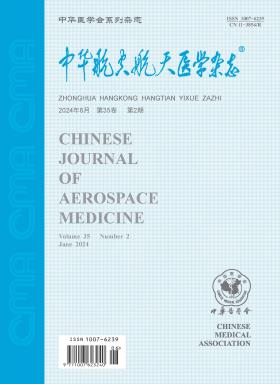海上飞行心理应激保护训练的实证研究
引用次数: 4
摘要
目的研究心理应激保护训练对飞行员海上作战任务的实际效果,为飞行员海上作战提供可行的技术和训练方法。方法选取40名执行海上飞行任务的飞行员作为研究对象。在飞行任务结束后半小时内采集他们的生理和客观指标,包括心率变异性(HRV)、脑电图(EEG)、应激程度自评量表。然后进行30分钟的心理应激保护训练。以上指标在培训结束后再次采集。比较心理应激保护训练前后飞行员的生理指标,评价训练效果。在海上模拟飞行中,对飞行员进行心理应激保护训练前后的状态进行了类似的比较。结果①HRV时域分析显示,心理应激保护训练后飞行员正常相邻神经网络间隔差>50 ms的百分比(PNN50)显著高于训练前(t=2.198, P<0.05);②频域HRV分析表明,心理应激保护训练后飞行员的归一化HF (HFnorm)显著高于训练前(t=7.102, P<0.01),心理应激保护训练后飞行员的归一化LF(LFnorm)显著低于训练前(t=7.102, P<0.01)。③脑电图分析显示,心理应激保护训练后飞行员的α波指数显著高于训练前(t=3.909, P<0.01), β波指数显著低于训练前(t=2.966, P<0.01)。④与飞行模拟任务数据相比,应力保护训练前各神经网络区间标准差(SDNN)值、相邻神经网络区间连续差值标准差和极低频值均显著降低(t=3.149、2.266、2.471,P<0.01或0.05)。β波指数显著升高(t=5.067, P<0.01)。应激保护训练显著提高了飞行员的SDNN、β波指数和HFnorm (t=2.621、3.062、4.757,P<0.05或0.01),显著降低了LFnorm (t=2.621, P<0.05)。⑤训练显著降低飞行员应激程度自评量表(t=7.833, P<0.01)。结论心理应激保护训练是飞行员执行海上飞行任务的有效途径。关键词:压力;心理;心率;问卷调查;培训本文章由计算机程序翻译,如有差异,请以英文原文为准。
Empirical study of psychological stress protection training for the flight over sea
Objective
To study the practical effect of psychological stress protection training on the pilots in over sea fight missions, and to provide pilots with feasible techniques and training methods for the flight over sea.
Methods
Forty pilots who performed the flight missions over sea were chosen as the research objects. Their physiological and objective indexes, including heart rate variability (HRV), EEG, self-rated scale of stress degree were collected within half an hour after the flight mission. Then, 30-min psychological stress protection training was carried out. The above indicators were collected again as the training finished. The physiological indexes were compared between the states of pilots before and after psychological stress protection training to assess the training effectiveness. Similar comparison was done between the states of pilots before and after psychological stress protection training in over sea flight simulation.
Results
①The HRV analysis in time domain indicated that the percentage of mormal adjacent NN interval difference >50 ms (PNN50) of pilots after psychological stress protection training was significantly higher than that before training(t=2.198, P<0.05). ②The HRV analysis in frequency domain indicated that the normalized HF (HFnorm) of pilots after psychological stress protection training was significantly higher than that before training (t=7.102, P<0.01), the normalized LF(LFnorm) of pilots after psychological stress protection training was significantly lower than that before training (t=7.102, P<0.01). ③The EEG analysis showed that α wave index of pilots after psychological stress protection training was significantly higher than that before training(t=3.909, P<0.01), but β wave index was significantly lower (t=2.966, P<0.01). ④As compared with the data from flight simulation task the values of standard deviations of all NN intervals (SDNN), standard deviation of successive difference between adjacent NN intervals and very low frequency were significantly lower before stress protection training (t=3.149, 2.266, 2.471, P<0.01 or 0.05). β wave index was significantly increased (t=5.067, P<0.01). SDNN, β wave indexes and HFnorm of pilots were significantly increased by stress protection training (t=2.621, 3.062, 4.757, P<0.05 or 0.01) while LFnorm significantly decreased (t=2.621, P<0.05). ⑤The self-rated scale of stress degree of pilots were significantly decreased by the training (t=7.833, P<0.01).
Conclusions
Psychological stress protection training is an effective way for the pilots performing over sea flight missions.
Key words:
Stress, psychological; Heart rate; Questionnaires; Training
求助全文
通过发布文献求助,成功后即可免费获取论文全文。
去求助
来源期刊

中华航空航天医学杂志
航空航天医学
自引率
0.00%
发文量
2962
期刊介绍:
The aim of Chinese Journal of Aerospace Medicine is to combine theory and practice, improve and popularize, actively advocate a hundred flowers bloom and a hundred schools of thought contend, advocate seeking truth from facts, promote the development of the related disciplines of aerospace medicine and human efficiency, and promote the exchange and penetration of aerospace medicine and human efficiency with other biomedical and engineering specialties.
Topics of interest for Chinese Journal of Aerospace Medicine include:
-The content of the journal belongs to the discipline of special medicine and military medicine, with the characteristics of multidisciplinary synthesis and cross-penetration, and mainly reflected in the aerospace industry, aerospace flight safety and efficiency, as well as the synthesis of special medicine, preventive medicine, environmental medicine, psychology, etc.
-Military aeromedicine (Air Force, Navy and Army aeromedicine) and civil aeromedicine, with a balance of aerospace medicine are the strengths of the journal.
-The change in aerospace medicine from a focus on promoting physiological compensatory adaptations to enhancing human performance under extreme environmental conditions is what the journal is helping to promote.
-The expansion of manuscripts in high altitude medicine is also a special emphasis of the journal.
 求助内容:
求助内容: 应助结果提醒方式:
应助结果提醒方式:


